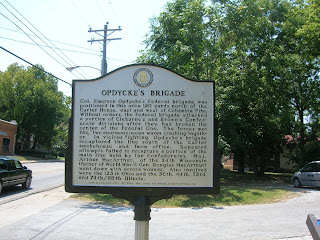How's that for a teaser shot? Sweating and smiling like an idiot! The Franklin battlefield was my favorite part of our whole vacation. It's a little surprising to stumble across such a bloody battlefield in the middle of a suburban neighborhood but that's exactly what Franklin is. What it lacks in size it makes up for in quality and rich history. The park was very well kept, the museum was excellent, the gift shop had a great selection of books, and the tour was well worth the $15 charge. I took a lot of pictures and I'll post some of them here with some notes. Hopefully my commentary isn't too confusing!
At the heart of the battle was the Carter House, and it is now a monument to the grisly fire of the engagement.
Here is the front of the Carter house. The tour was through the house and then across the property, it focused a lot on the Carter family, and their actions during the battle. The house was used as a federal headquarters prior to the battle, and shielded the family during the conflict.
A few yards away from the house is the farm office (on the left) and the smoke house (on the right)
Note the damage to the farm office. It is widely considered the most battle damaged Civil War structure still standing.
A close up of the damage.
Here is a shot of the scarring to the smoke house.
A shot of the farm office and smoke house from the steps of the Carter house back porch.
The back of the Carter house on the right, slave quarters on the left.
Bullet holes in the Carter house on the back porch.
Gun marking a federal battery.
Another gun placed next to the smoke house.
The view along the second line of Union fortifications. Standing by the artillery positions next to the smoke house, facing northwest down the federal position.
Standing behind the second line, the straw bales mark the main line.
Further northwest down the line, facing west.
The beautiful wife, braving the heat for her overly excited husband.
Plaque for the 183rd Ohio, facing the confederate approach.
North of the Carter house, from this position Opdycke's Brigade counter charged the rebels as they broke through the Union line and stemmed the breakthrough.
From the front of the Carter house facing south. A well known pizza chain, sitting on the site of some of the bloodiest fighting of the battle, the cotton gin.
There are a few preservation groups working to acquire this property and rebuild the cotton gin and restore the ground to it's historic condition before the 140th anniversary of the battle.
Plaque commemorating the struggle for the landmark.
Cleburne park, commemorating the place where General Cleburne was killed.
Plaque marking the confederate approach to the federal left.
Another shot.
One of the sad stories of the battle is that of Todd Carter, who after 3 years at war returned home with the 20th Tennessee and was killed a few hundred yards from the house he was born in, he died there a few days later.























































